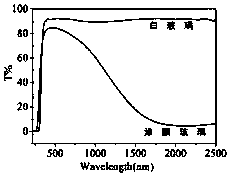Preparation method of core-shell structural high-transparency low-radiation heat-insulating composite nanometer coating
A composite nanomaterial and core-shell structure technology is applied in the field of preparation of high-transparency and low-radiation heat-insulating composite nanocoatings to achieve the effects of low cost, high repeatability and high efficiency
- Summary
- Abstract
- Description
- Claims
- Application Information
AI Technical Summary
Problems solved by technology
Method used
Image
Examples
Embodiment 1
[0034] Example 1 Preparation of highly transparent and low-radiation heat-insulating nanomaterials with core-shell structure
[0035] 1) Add 2% by weight of silane coupling agent KH570 and tin antimony oxide particles to absolute ethanol, mix well and then use a high-energy ball mill for ball milling with a ball-to-material ratio of 30:1, ball milling speed 300r / min, hours, separated by filtration, washed, and dried to obtain evenly modified core layer antimony tin oxide nanoparticles, wherein the addition of antimony tin oxide particles is 200g / L;
[0036] 2) Disperse the modified core-layer antimony oxide nanoparticles obtained in step 1), tetrabutyl titanate, the precursor of shell-layer nanoparticles, and saturated ammonia solution into absolute ethanol solution, and then perform high-speed ball milling. The material ratio is 10:1, the ball milling speed is 500r / min, and the ball milling is 32 hours, then filtered, washed, and dried to obtain a composite nanomaterial with ...
Embodiment 2
[0042] Example 2 Preparation of highly transparent and low-radiation heat-insulating nanomaterials with core-shell structure
[0043] 1) Add 0.9% by weight of silane coupling agent KH550 and indium tin oxide particles to isopropanol, mix well and then use a high-energy ball mill to mill with a ball-to-material ratio of 20:1, a ball mill speed of 500r / min, and a ball mill of 2 hours, separated by filtration, washed, and dried to obtain evenly modified core layer indium tin oxide nanoparticles with particle diameters, wherein the addition of indium tin oxide particles is 180g / L;
[0044] 2) Disperse the modified core-layer indium tin oxide nanoparticles obtained in step 1), the precursor of shell-layer nanoparticles-tetraethyl titanate, and saturated ammonia solution into isopropanol solution, and then perform high-speed ball milling. The material ratio is 15:1, the ball milling speed is 400r / min, and the ball milling is 40 hours, then filtered, washed, and dried to obtain a com...
Embodiment 3
[0050] Example 3 Preparation of a high-transparency, low-emissivity heat-insulating nanomaterial with a core-shell structure
[0051] 1) Add 2.5% by weight of silane coupling agent KH560 and vanadium dioxide particles to methanol, mix evenly and use a high-energy ball mill for ball milling with a ball-to-material ratio of 25:1, ball milling speed of 400r / min, and ball milling for 4 hours. Separation by filtration, washing, and drying to obtain vanadium dioxide nanoparticles in the core layer with uniform particle size modification, wherein the addition of vanadium dioxide particles is 150g / L;
[0052] 2) Disperse the modified core-layer vanadium dioxide nanoparticles and shell-layer nanoparticle precursors-titanium sulfate and saturated ammonia solution obtained in step 1) into methanol solution, and then perform high-speed ball milling with a ball-to-material ratio of 25 : 1, ball milling speed 200r / min, ball milling 48 hours, then filter, wash, dry, obtain the composite nano...
PUM
| Property | Measurement | Unit |
|---|---|---|
| particle diameter | aaaaa | aaaaa |
| particle size | aaaaa | aaaaa |
| size | aaaaa | aaaaa |
Abstract
Description
Claims
Application Information
 Login to View More
Login to View More - R&D
- Intellectual Property
- Life Sciences
- Materials
- Tech Scout
- Unparalleled Data Quality
- Higher Quality Content
- 60% Fewer Hallucinations
Browse by: Latest US Patents, China's latest patents, Technical Efficacy Thesaurus, Application Domain, Technology Topic, Popular Technical Reports.
© 2025 PatSnap. All rights reserved.Legal|Privacy policy|Modern Slavery Act Transparency Statement|Sitemap|About US| Contact US: help@patsnap.com


